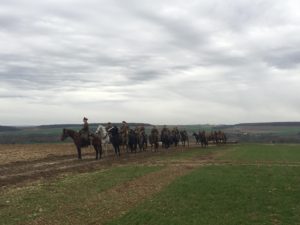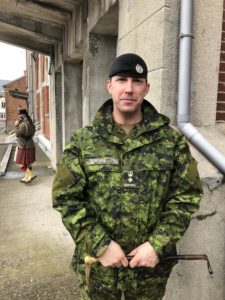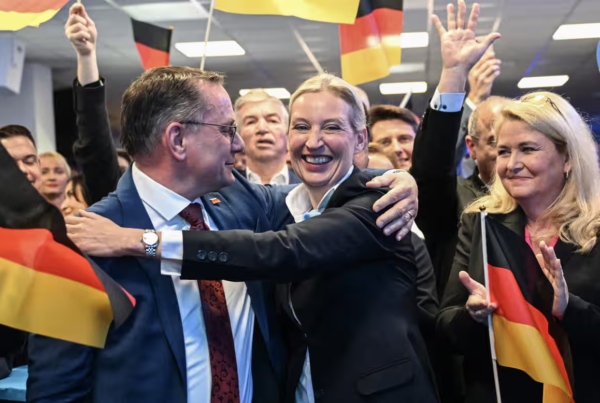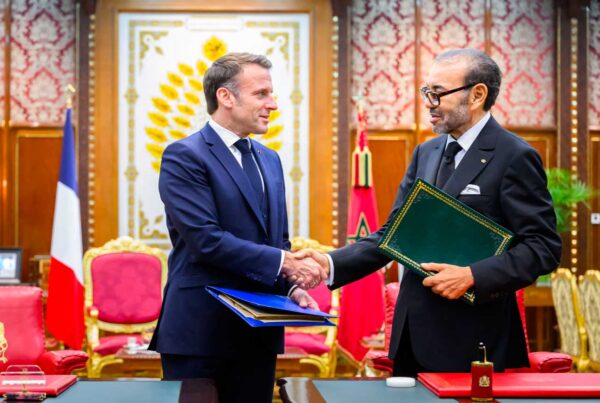By Isabelle Ava-Pointon

Moreuil
On March 30th, 2018, the Canadian soldiers of the Lord Strathcona’s Horse (Royal Canadians) Regiment, the townspeople of Moreuil, and visitors from all over the world came together to commemorate the 100th anniversary of the Battle of Moreuil Wood.
Known as the “Last Great Cavalry Charge”, it pitched 75 Canadian cavalry soldiers, on horseback and brandishing sabres, against approximately 300 Germans armed with artillery and machine guns. It was a slaughter reminiscent of the infamous Charge of the Light Brigade during the Crimean War. Remarkably, however, this engagement was not a complete defeat. Although the Canadians suffered 70% casualties, their wild charge so unsettled the Germans that the latter withdrew from the position.
The commanding officer, Lieutenant Gordon Muriel Flowerdew, died of his wounds the day following the battle, and posthumously won a Victoria Cross, the highest military award in the British Empire. The epic engagement was commemorated in a famous painting by war artist Sir Alfred Munnings. The story of the battle has was portrayed in the Canadian play Mary’s Wedding. Apart from its impact on the Canadian and British psyche, the battle is in and of itself a metaphor for the entire war: outdated tactics clashing with modern technology. Only in the First World War could one find cavalry charging machine guns… and emerging victorious.
The commemorative events marking the centennial included a re-creation of Flowerdew’s charge by twenty Strathcona soldiers on horseback, a memorial service at the village church with readings from soldiers’ letters, as well as a military parade through the town. Many of the events were accompanied by traditional bagpipe military music played by the Somme Battlefield Pipe Band, a strange but lovely organization of French volunteers who dress as highlanders and play the bagpipes flawlessly. Another important aspect of commemoration was community-building, as soldiers, schoolchildren, mayors and pipers all shared meals of traditional baguette sandwiches and beer.
The Commanding Officer of the Lord Strathcona’s Horse (Royal Canadians) agreed to speak with this reporter about historical continuity in his regiment, the importance of commemoration, and the role of the Canadian Armed Forces in today’s world.

Lieutenant-Colonel Mark Lubiniecki
Isabelle Ava-Pointon: First of all, it was a very impressive ceremony this morning, lots of complicated logistics, how long have the Strathconas been organizing this commemoration?
Lieutenant-Colonel Mark Lubiniecki: We had formed a committee in 2011 to start the planning of the logistics, planning with Jean-Paul Brunel and the town of Moreuil, and then really we began to fully commit to the detailed planning and logistics about 18 months ago, truly getting into the detailed work.
I: Well it was very impressive, so think all your hard work paid off. So I take it the LSH is no longer a traditional cavalry regiment, I believe you are now armoured?
L: Yes, we’re an armoured regiment comprised of tanks, the Leopard 2 which Canada uses now, as well as armoured reconnaissance. But we still do maintain a tie to the past, with ceremonial mounted troop. We have about 20 soldiers, and those are the soldiers you saw today on horseback, that perform the ceremonial ride which is very similar to what the Royal Canadian Mounted Police do. We travel across Canada between April and September putting on shows at a wide variety of venues for numerous different organizations, be it small schools or larger events like the Calgary Stampede. This enables us to maintain that link to the past, and really connect with Canadians – that is the focus of the Ceremonial Mounted Troop. A lot of the soldiers use their time in Mounted Troop, for a mental or physical healing; working with animals is very therapeutic for them. So some soldiers come out of the fighting troops and do need a bit of a break, it allows them an opportunity to continue to contribute to the Regiment and the Canadian Armed Forces, while also allowing them to focus on themselves a little bit more than they are able to when they are constantly being deployed to the field for training or overseas operations.
I: Very important. And would you say that armoured regiments now perform the same sort of operational duties as cavalry did back in the day?
L: Yes I think we have just seen a transition, or a growth with technology. The fundamentals remain the same: dominating and taking control of the ground. But then working very closely in the combined arms team with the infantry who are able to hold the ground and fight in the close areas: dense woods or built-up areas. And then engineers and artillery are the forces we combine to make that Combined Arms Team, and it is this grouping of resources that enable us to have the effect that we need on the battlefield today. So a lot of the fundamentals remain the same.
I: Makes sense. So how are the Strathconas currently engaged in the Canadian Armed Forces’ “Strong Secure Engaged” new national security program?
L: Domestically, the soldiers remain committed to working in support of Canada: in Western Canada a primary example would be Operation Lentus which focuses on firefighting efforts against wildfires as well as support to communities that become flooded due to natural disasters such as spring runoff and flooding. So we see, almost every summer, support to British Columbia for forest fires, or Saskatchewan, Alberta, Manitoba for floods. Domestically that remains one of the largest commitments that we have. We just had 200 soldiers return from a seven month deployment to Ukraine as well as a Reconnaissance Troop attached to a Canadian Battle Group in Latvia as part of the Enhanced Forward Presence Battlegroup,.return after their deployment there. There remain a large number of individual deployments for leadership at all levels into NATO, UN, and Allied Headquarters for expeditionary operations as well.
I: The soldiers who were in Ukraine were Part of Operation UNIFIER?
L: That’s right. I was fortunate enough to have commanded that operation alongside CWO Robert Clarke, my Regimental Sergeants Major. We have seen an increase in operations over the last year. This summer we transition back into the “Road to High Readiness” which is our high-readiness training cycle, which spans about 6 to 10 months and sees us go through a number of gateways that prepare us to be deployable by the Government of Canada anywhere in the world. So as of the 1st of July 2019, we will be part of the high-readiness brigade, and I think we can probably anticipate seeing similar deployments to what we’ve seen up to this point: Latvia, Ukraine, Iraq etc.
I: Ukraine’s actually a particular research interest of mine, so I was wondering, since you spent seven months there working, I believe it’s training the security forces?
L: Yes.
I: What were your impressions of the overall security situation in Ukraine?
L: Canadian soldiers deployed to Ukraine are employed in a pure training role, helping to modernize and professionalize their military to better align with NATO standards. The Candian soldiers as part of Op UNIFIER are not authorized to operate in the East Donbass region, there’s a bit of a buffer zone that the Government of Canada has placed on the Canadian soldiers, because we’re not there in the mentorship of the fighting, we’re there in the training role, as you indicated. They have a professional army that is restructuring itself and they are very eager and motivated to develop quickly and modernize, based on the fact that it is very real to them, most of them are deploying to the East into the fight. So we saw a huge interest in medical training and improving medical skills, counter-Improvised Explosive Device training, so they could identify and defeat the devices before they are initiated. And small-arms tactic was another one of the interests that they had. Certainly the tactical level is very keen and very interested in developing. I think that, like a number of former Soviet-bloc states, there are some challenges that they face at the upper echelons, but certainly at the level we worked with they were extremely motivated to learn and progress as an Armed Force.
I: Last question, what do you think is the role of commemoration in working towards a more stable and just and peaceful global society?
L: I think that World War One was the Great War, the “War to End All Wars”, and yet we continue to have conflicts, so without remembering our past we are doomed to repeat it. I think as Canadians we are so far removed from most of the conflict, we’re so blessed and fortunate to live in a country free from oppression or internal strife. So for us as Canadians to remember and commemorate these battles I think it’s even more important than what we see in Europe. For these people it has been generations of family that have lived it, and you can see it on their faces how proud they are, but how they still remember. So I think that being removed, as Canadians, we run the risk of forgetting if we don’t make the effort to commemorate and to celebrate what has been achieved by those before us and what was ultimately sacrificed by those before us as well.
Other posts that may interest you:
- The Trouble with ‘Ecocide’
- Carbon dioxide removal – hit or miss?
- Local Victories for Turkish Opposition — A Sign of Hope?
- Are France and Japan a Mismatch Made in Heaven?
- A Reflection on Dark Tourism
Discover more from The Sundial Press
Subscribe to get the latest posts sent to your email.





